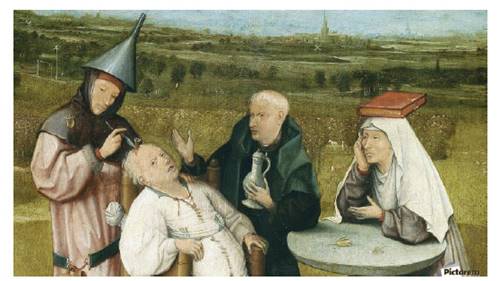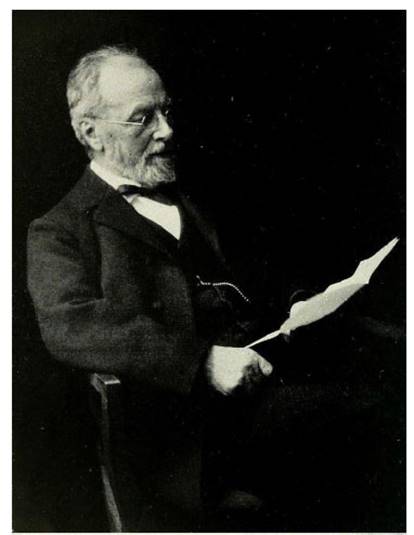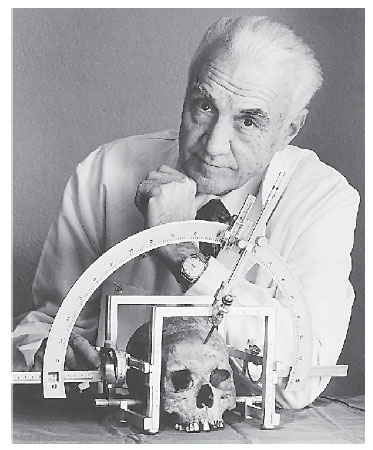To the Editors:
Psychosurgery, or Behavioral Surgery, is formed by the conjunction of two distinct areas: Surgery (Cartesian and anatomical) and Psychiatry (essentially clinical and phenomenological). We can define it as the scientific treatment of mental disorders through brain surgery. Its development since its inception is surrounded by intriguing milestones, which give us lessons and hope for the future of the development of surgery among neuropsychiatry 1.
The historical background of Psychosurgery dates back to about 40,000 years. Archaeological findings revealed thousands of perforated skulls, a surgery called trepanation, performed to release “bad spirits” that doctors believed were responsible for the madness 2. In the Middle Ages, false operations were performed by charlatans to extract the so-called “stone of madness” which, they wanted people to believe, was the source of mental illness (Figure 1) 3. But it was not until the nineteenth century that strictly scientific approaches to psychosurgery were first elaborated. Gottlieb Burckhardt in 1894 performed surgery to selectively destroy the frontal lobes of various patients aiming to control psychotic symptoms (Figure 2) 4. The knowledge that this part of the brain was involved with emotions was already known from clinical cases, especially the famous Phineas Gage case, considered as one of the first scientific evidence that damage to the frontal lobes could alter personality, emotions, and social interactions 5.

Figure 1 “The Extraction of The Stone of Madness” by Hieronymus Bosch, 1494. Museo del Prado,Madrid, Spain

Figure 2 Gottlieb Burckhardt. From: http://thejns.org/doi/abs/10.3171/FOC/2008/25/7/E9 - Journal of Neuroscience
Nowadays
The major divide between early and modern psychosurgery was the development of stereotactic surgery by Spiegel and Wycis in 1947. Through it, the complication rate dropped significantly and continued its progress thanks to the advance of neuroimaging techniques coupled to the procedure. Initially, it was done with manual calculations and simple cranial radiographs 9. Today there are programs adapted to nuclear magnetic resonance, that precisely calculate and make the psychosurgical target something of extreme accuracy and small risks to patients. The development of radiosurgery by the Swedish neurosurgeon Lars Leksell in the 1960s took us to another level, now allowing doctors to remove tiny amounts of brain tissue without opening the skull (Figure 3). Leksell continued his work on stereotactic radiosurgery and refinement of stereotactic methods, and the first prototype Gamma Knife was installed1969 10.
Technical progress continued into the next century by pioneers such as Victor Horsley and Harvey Cushing who made surgical approaches to the brain not possible before 6. The first consistent technique for psychosurgery was developed by the Portuguese physician Egas Moniz, performed in 1935, a technique known as leukotomy or lobotomy which consisted of cutting fiber tracts between the thalamus and the frontal lobes, an attempt to reduce psychosis and severe depression or violent behavior in patients who did not respond to the treatments of the time. Moniz was awarded the Nobel Prize in 1949 7. Walter Freeman and James Watts in the US enthusiastically adopted the Moniz procedure. They developed a quick and easy surgical intervention called “transorbital leukotomy” that could be done within minutes under local anesthesia in a doctor’s office. It consisted of the insertion of an icebreaker through the roof of the orbits, followed by a rapid lateral movement to break the fibers, a method still lacking robust scientific evidence at the time. Between 1945 and 1956, more than 50 000 people underwent lobotomy worldwide, many cases with no true indications. This created a stigma about psychosurgery that could only be overcome with effort at the beginning of the present century 8.
Thus, we arrive at current times with psychosurgery still under development. After breaking the barriers and stigmas created by lobotomy, we still have great challenges. Modern therapeutic indications for psychosurgery follow very specific protocols, limited to cases severely refractory to available treatments and with significant associated distress. We must remember that the development of psychosurgery is closely linked to the development of all clinical neurosciences, as well as cognitive and basic neuroscience; we have celebrated 50 years since the Gamma Knife range, and psychosurgery continues inspiring us to a future both challenging and fascinating in the way of development of scientific knowledge in the field of Neuropsychiatry.
















